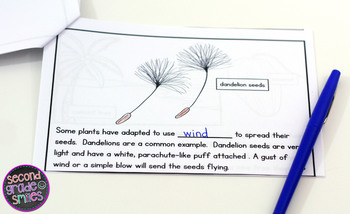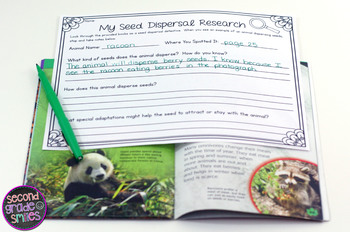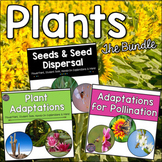Parts of a Seed & Plant Adaptations for Seed Dispersal
- Zip
What educators are saying
Also included in
- This primary science bundle was created to help teach students about adaptations that help plants meet their needs for for water, sunlight, space, pollination, and seed dispersal. It includes three PowerPoint presentations with corresponding student books for note-taking, hands-on explorations andPrice $13.00Original Price $17.00Save $4.00
Description
Teach about seeds and plant adaptations for seed dispersal! Includes hands-on activities, a PowerPoint, a student book, and more!
Here’s what you’ll find inside:
• Seed Adaptation PowerPoint & Student Book – Click through and discuss this seven-slide PowerPoint, complete with real photographs and a few sentences of information per slide, to introduce students to examples of ways that plants have adapted to disperse their seeds. Students can follow along in their student books and fill in the blanks as they find the needed information in the slides. The last page also asks students to apply the information learned by providing examples of seeds they see where they live. I like to store these books in a pocket in my students’ science notebooks so they can refer back to them throughout the unit. They are also great to send home to practice fluent reading and share what students are learning at school with their families. (Please note that although the words are the same as those on the PowerPoint, pictures in the student book are in clip art form, rather than photographs, to allow for easy black and white copying.)
• Parts of a Seed Note-taking Handout – This chart makes a great insert for science notebooks. The three main parts of the beans seed (embryo, cotyledon, and seed coat) are labeled and space is given for students to add a few additional notes. I like to note that the embryo is the “baby plant”, the cotyledon is “plant food”, and the seed’s coat “protects the plant” together with my second graders.
• What’s in a Seed? Hands-On Observations and Experiment – In this activity, students will observe a lima bean seed inside and out. You will need to provide each student with a seed that has been soaked in water over night, a small piece of paper towel, and a plastic baggie. A hand lens is also useful if you have them available. Students will observe the seed and then take it apart and sketch and label the seed parts found inside. Next, all the seed parts will be placed in a plastic baggie. Students will hypothesize which parts will grow into bean plants. Place them in a sunny spot and allow students to observe and draw conclusions. Students can transplant their seedlings at home or school if you wish.
• Seed Dispersal Sort It! – Students will examine the pictures of seeds provided and sort by seed dispersal adaptation. This is a great activity for your whole class, a small group, or partners. Encourage students to discuss why they think the seed belongs in a specific category as they sort. An optional recording sheet is provided. Note that some seeds may fit into more than one category and focus on reasoning over “correct” answers. If you would like to extend this activity, students can research the seed dispersal mechanisms of any unfamiliar plants and report back to the class.
• My Seed Dispersal Research – This activity is a great option for a science center that can be done in pairs or individually. Students will be seed dispersal detectives as they search through provided books for examples of animals dispersing seeds and make note of them on this printable handout. Please note that you will need to preview the books you provide to be sure they contain examples of animals dispersing seeds. I have found that most animal encyclopedia-type options contain at least a few pictures of birds eating berries, squirrels hiding acorns, etc.
• Design a Plant – Another easy-prep option for your science center! Students will imagine a plant that has adapted a special way to disperse its seeds, sketch it, and describe its seed dispersal process using this printable Students love to share their responses to this prompt!
Teachers Like You Said...
⭐⭐⭐⭐⭐ Extremely satisfied
"This was an excellent resource when I taught our plant unit. The students were engaged and enjoyed learning about how seeds "travel". Excellent resource." - Tracy D.
⭐⭐⭐⭐⭐ Extremely satisfied
"My students loved the pictures in the slides. The real life images and examples were super helpful. I actually used this for an observation, and it went very well. The kids were excited to give their answers in the sorting activity. I used some of the more challenging sorting pictures for my students who finished early. This is a great resource!" - Kaitlynn S.
These activities relate to the following Next Generation Science Standard:
2.LS.2.2 : Develop a simple model that mimics the function of an animal in dispersing seeds or pollinating plants.
Related Products
If you and your students enjoy this resource, please consider following my store. Freebies and new products are posted regularly. You can contact me with any questions or requests at secondgradesmilesstore@gmail.com.
- Amanda Taylor @ Second Grade Smiles






